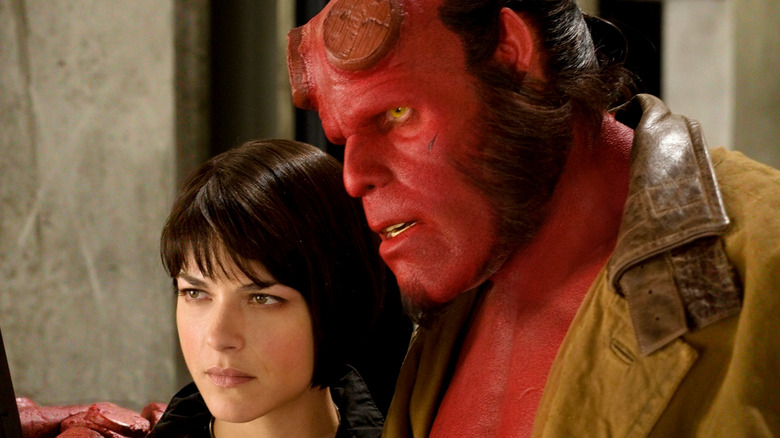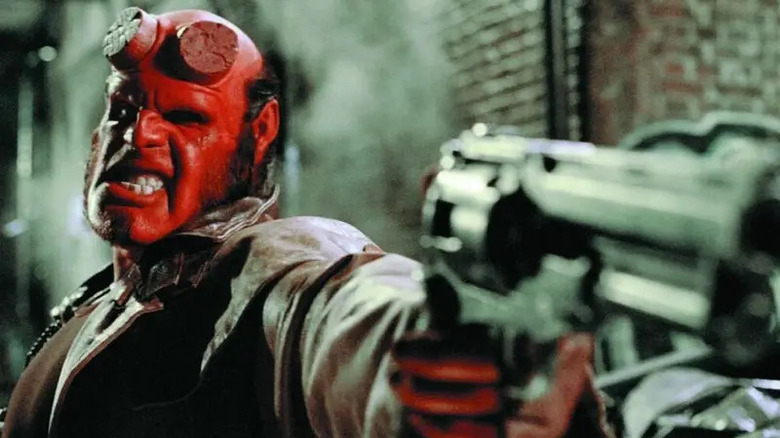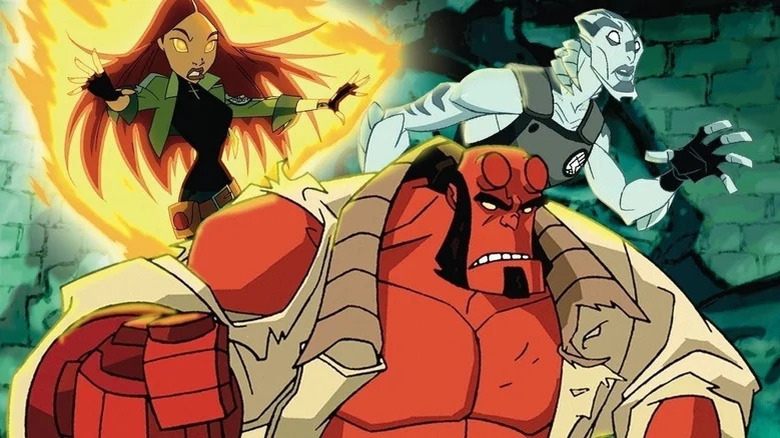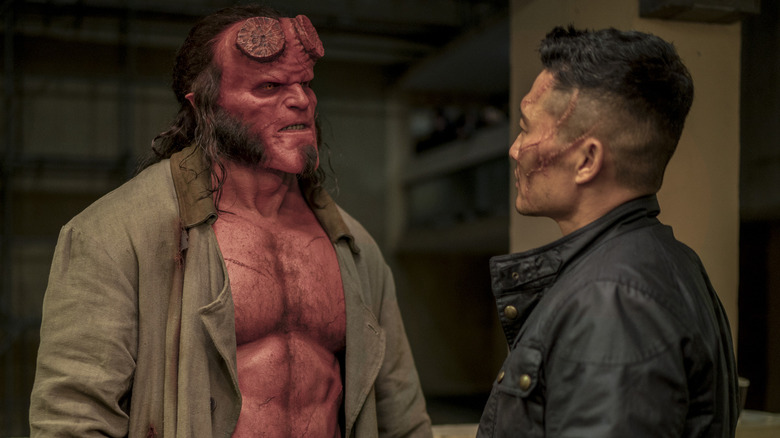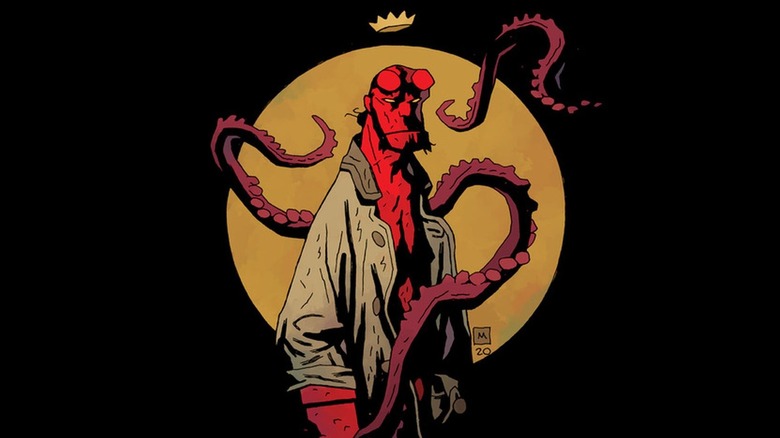How To Watch The Hellboy Movies In Order
2024 is the 30th anniversary of Hellboy, the demonic superhero created by comic artist Mike Mignola, not to mention his two monster-hunting partners: fishman Abe Sapien and the firestarter Liz Sherman.
In 1944, Nazis led by Grigori Rasputin (yes, the Rasputin) opened a portal to Hell to summon the harbinger of the apocalypse. They succeeded — the being brought forth was a demon child named Anung Un Rama ("And upon his brow is set a crown of flame"). The Nazis were defeated by Allied soldiers and the child was adopted by Professor Trevor Bruttenholm and named Hellboy. Professor "Broom" raised his son into the top agent of the Bureau for Paranormal Research and Defense (The B.P.R.D.). Hellboy approaches his job with the attitude of a working stiff and is really unenthusiastic about his destiny to destroy the world.
Hellboy is one of the most successful superhero comic characters outside of the Marvel/DC duopoly; his adventures bridge the gaps between fantasy, horror, and good old-fashioned pulp. Unlike his contemporaries superheroes, however, Hellboy hasn't had the most successful time on film. "Hellboy" has been adapted as an unfinished trilogy and then a failed reboot. In 2024, Mignola spearheaded yet another go at it with a low-budget reboot titled "Hellboy: The Crooked Man."
If you want to enjoy the "Hellboy" films, how do you watch them?
The correct order to watch the original Hellboy movies
The first two "Hellboy" films were directed by Guillermo del Toro after he'd proven he could make a superhero blockbuster with "Blade II." In turn, "Hellboy" helped turn del Toro into the filmmaker who would direct "Pan's Labyrinth, "The Shape of Water," and many other great pictures.
Longtime del Toro collaborator Ron Perlman plays Hellboy himself in the director's movies, over the objections of studio heads who wanted a bigger name. Mignola and del Toro are two peas in a pod; they both love ghost stories, monster movies, and comic book pulp art. Unlike Mignola, though, del Toro is a romantic and brings that spirit to Hellboy's world.
You should watch del Toro's "Hellboy" movies in release date and chronological order:
-
"Hellboy" (2004) – Decades after Hellboy's arrival on Earth, Rasputin returns. He intends to force Hellboy to fulfill his destiny and summon the seven-headed dragon called the Ogdru Jahad, who will in turn create Hell on Earth. The first "Hellboy" movie is loosely based on the first comic arc, "Seed of Destruction."
-
"Hellboy II: The Golden Army" (2008) – Hellboy and the B.P.R.D.'s existence is exposed to the public, forcing Big Red to question more deeply than ever if he wants to save the world. He has to decide soon, because Elf Prince Nuada (Luke Goss) seeks to awaken the titular army of clockwork robots to wipe out humanity and restore the balance of nature. "The Golden Army" is an original story; it's the best "Hellboy" movie but also the one least like the comics.
And that's it. Pretty easy, huh? While they make many changes to the comics, the del Toro "Hellboy" films should still be watched first. Not just because they were released first, but because they detail Hellboy's origin in the most depth.
The story tragically stops after "Golden Army"; del Toro had ideas for a "Hellboy III", but that trilogy closer remained in development hell for years before being finally declared dead in 2017. Mignola, dissatisfied with "The Golden Army" and losing creative control of his baby, has since taken the reins on subsequent "Hellboy" films that are closer to his original vision (though not necessarily "better").
The animated Hellboy movies are next in order
You may not know that there were two animated "Hellboy" films too. Released between the del Toro films in 2006-2007, they share the same main cast as those movies and del Toro produced them. They're not part of the same continuity, though.
The films employed character designer Sean Galloway while the second was co-directed by Victor Cook; both went on to work on the fantastic (but short-lived) "The Spectacular Spider-Man" cartoon. The stylistic resemblance to that series is uncanny.
My advice is to watch "Hellboy Animated" after the del Toro duology. They're standalone films that assume some familiarity with the characters and setting. Plus, they're best enjoyed not as an appetizer, but as satiation if you want more of Ron Perlman's Hellboy.
As for what order to watch the animated "Hellboy" films on their own:
- "Hellboy: Sword of Storms" (2006) – Hellboy, Abe, and Liz face off against a pair of ancient Japanese demons who want the titular sword. The story of "Sword of Storms" is mostly original, but the Japanese setting (and some of the monsters) take after the Hellboy one-shot "Heads."
-
"Hellboy: Blood and Iron" (2007) – While the B.P.R.D investigates a haunted mansion, they come face-to-face with the Hungarian vampire Erzsebet Ondrushko and her master Hecate (the Greek Goddess of the Underworld). The film has a "Memento" like structure, intertwining the present-day storyline with reverse-chronological flashbacks to 1939 when Professor Broom first defeated Ondrushko. In the same way "Hellboy" (2004) loosely adapts "Seed of Destruction," "Blood and Iron" is a loose retelling of the second "Hellboy" comic mini-series: "Wake the Devil."
Like the del Toro "Hellboy," the animated films were meant to continue with a third film that never got the green light. This one, titled "The Phantom Claw," would've featured Hellboy and B.P.R.D. Professor Kate Corrigan investigating the castle where Hellboy came to Earth. While there, they'd meet both Rapustin and the ghost of Nazi-busting vigilante Lobster Johnson. Writer Tad Stones has confirmed that "Phantom Claw" would've been mostly inspired by comic mini-series "Conqueror Worm," where Hellboy and the ghostly Lobster teamed up. Alas, it wasn't meant to be.
The Hellboy reboots are last on the watch list
The next two "Hellboy" films have since gone back to live-action. The 2019 "Hellboy," directed by Neil Marshall and starring David Harbour as Hellboy, was intended to kickstart a new franchise. It didn't take, though, and Harbour has moved on from the failure of "Hellboy." Mignola hasn't given up, however, hence the more modest "Hellboy: The Crooked Man," directed by Brian Taylor and starring Jack Kesy as Hellboy.
There's no strict order here between the two of them, since they aren't in canon with each other nor do they share a main cast. By default, release order is the way to go:
- "Hellboy" (2019) – Hellboy must face off against Nimue the Blood Queen, a witch from Arthurian times who wants him to be her king of the apocalypse. Presumably to separate it from the del Toro films, this Hellboy has two different sidekicks. Instead of Abe and Liz, it's the Irish medium Alice Monaghan (Sasha Lane) and werecat Major Ben Daimio (Daniel Dae Kim). A hodgepodge of different "Hellboy" comics, the film mostly takes after a trilogy made up of "Darkness Calls," "The Wild Hunt," and "The Storm and the Fury."
- "Hellboy: The Crooked Man" – In the 1950s, a young and green Hellboy is stranded in the Appalachian mountains with his fellow B.P.R.D. agent Bobbie Jo Song (Adeline Rudolph), forcing them to battle the sadistic ghost Jeremiah Witkins, aka the Crooked Man (played by Martin Bassindale). "The Crooked Man" is directly adapted from the "Hellboy" comic mini-series of the same name (written by Mignola, drawn by Richard Corben).
2024 also saw another "Hellboy" adjacent film released: the biographical documentary "Mike Mignola: Drawing Monsters," exploring Mignola's life and how he created his demonic magnum opus. If you want a behind-the-scenes peek after finishing all the "Hellboy" movies, "Drawing Monsters" is worth your time. Speaking of: if the movies win you over, then you should check out Mike Mignola's original "Hellboy" comics while you're at. Even the del Toro "Hellboy" movies don't quite reach the same heights as the comics.
What is the best order to read the Hellboy comics?
Mignola is one of the greatest American comic artists of his generation, with a style that eschews naturalism in favor of images possible only with a pen and paper. In a foreword to "Wake the Devil," Alan Moore compared Mignola's work on "Hellboy" to Jack Kirby, the main mastermind of the Marvel Universe (and its literal God). Mignola's imagination in creating wondrous creatures and worlds rivals the King. However, Mignola uses shadowed shading to bring gothic tones to the pulp. Even when his comics are colorful, they're dark.
"Hellboy" is a collection of one-shots and mini-series, not a single serialized comic series. I think this makes the world more accessible than Marvel or DC, since the stories work better on their own terms. If you're a completionist, though, you've got options for a sorted ordering. The "Hellboy" comics have been collected across numerous editions:
- The "Hellboy" trade paperbacks, collected in volumes 1-12 plus "Hellboy in Hell" volumes 1-2. These collected the stories in roughly sequential/publication order. Some volumes contain a single "Hellboy" mini-series, others are structured more like short story anthologies.
- The "Hellboy" Library Editions Volumes 1-7, larger hardcover printings that each more or less collect two-in-one of the paperback volumes.
- The "Hellboy" Omnibus Volumes 1-4, collecting the essential Hellboy mini-series in 300-400 page paperback bindings. If you choose these, you should also pick out "Hellboy: The Essential Short Stories" Volumes 1-2, which include several stories left out of the omnibus editions.
- "Monster-Sized Hellboy," a 1500+ page oversized hardcover collecting every major "Hellboy" comic in chronological order.
These are the essential "Hellboy" comic stories, collected across all these editions, in roughly chronological order.
- "Seed of Destruction" (scripted by John Byrne, plotted and drawn by Mignola) — The first "Hellboy" comic, depicting his origin story. It then jumps 50 years to 1994, where Rasputin tries to trigger the apocalypse via Hellboy.
- "The Wolves of Saint August" (by Mignola) — The second full-length "Hellboy" comic, told in two issues. Inspired by an Irish folktale of St. Patrick turning pagans into werewolves, Hellboy fights some lycanthropes. The first appearance of Professor Corrigan.
- "The Corpse" (by Mignola) — Summoned by an Irish couple, Hellboy discovers the Fae have stolen and replaced their baby. To rescue her, Hellboy must bury a talking corpse before dawn. Both the baby Hellboy saves (Alice Monaghan) and the fairy he defeats (Gruagach) become important later.
- "The Baba Yaga" (by Mignola) — A short story of Hellboy fighting the titular witch from Russian folklore. The Baba Yaga becomes a recurring enemy for Hellboy.
- "Wake the Devil" (by Mignola) — Rasputin and his old Nazi allies again strike at Hellboy, this time aided by Hecate and the Dracula-esque vampire Vladimir Giurescu.
- "Almost Colossus" (by Mignola) — A sequel to "Wake the Devil," where Hellboy must hunt a homunculus created during that story.
- "The Right Hand of Doom" (by Mignola) — A short, featuring Hellboy discussing his history and future with a priest.
- "Box Full of Evil" (by Mignola) — The demon Ualac is freed from an enchanted prison and tries to usurp Hellboy's fate of destruction.
- "Conqueror Worm" (by Mignola) — Aided by the ghost of Lobster Johnson, Hellboy must infiltrate a mountain castle where Nazi cyborg Herman von Klempt is at work. Features narration taken from Edgar Allan Poe's "Conqueror Worm" poem.
- "The Third Wish" (by Mignola) — After leaving the B.P.R.D. in "Conqueror Worm," Hellboy is kidnapped by mermaids and brought to the sea witch Bog Roosh.
- "The Island" (by Mignola) — Stranded at sea after "The Third Wish," Hellboy comes to a ghostly island. This story reveals the origin of the Ogdru Jahad and Hellboy's Right Hand of Doom.
- "Darkness Calls" (written by Mignola, drawn by Duncan Fegredo) — Hellboy is lured into the Baba Yaga's dimension and must fight immortal warrior Koschei the Deathless. Meanwhile, Gruagach has resurrected Nimue the Blood Queen to destroy Hellboy.
- "The Wild Hunt" (by Mignola and Fegredo) — Hellboy is called to England for a giant hunt, discovers new secrets to his heritage, and falls in love.
- "The Storm and the Fury" (by Mignola and Fegredo) — Hellboy and Nimue finally clash for the fate of England and the world.
- "Hellboy in Hell" (by Mignola) — The 10-issue epilogue to Hellboy's story, as he finally goes home.
The "Hellboy" universe (or "Mignolaverse") has many more stories than these. It's so vast that trying to read all of it in strict chronological order is a fool's errand. But follow the above order and you'll get the core "Hellboy" story and, if your tastes are like mine, one of your most satisfying comic book journeys ever.
